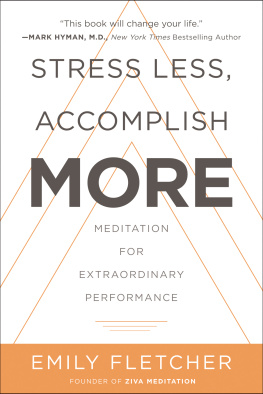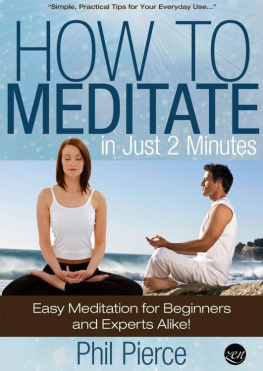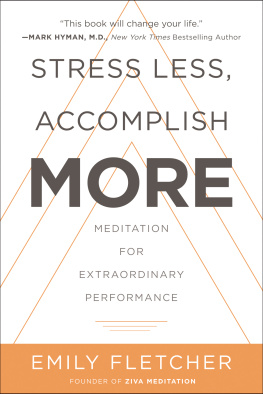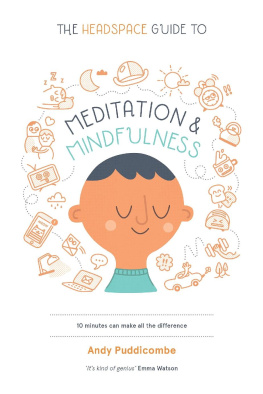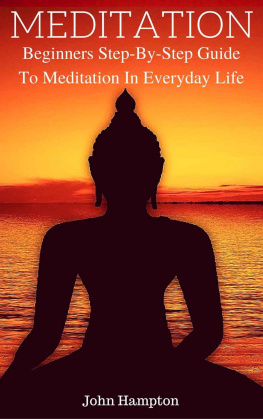Contents
This book is dedicated to everyone who has tried meditation and felt like a failure.
You are not a meditation failure; you just havent been taught yet.
This book will teach you.
When I first met Emily, we were both lecturing at an event in Greece. She was telling me about her meditation practice, and in the back of my mind I was thinking, Oh, sure. I studied Zen Buddhism. Ive gone on retreats. Ive meditated for twelve hours a day. Ive also been a yoga teacher and still do yoga all the time. I have plenty of health hacks in my tool kit. I felt like I already had my stress under control, but I was intrigued by what she had to say.
The more I listened to Emily, the more I realized that she was talking about something elsesomething deeper, more powerful, and potentially life-changing. What really got my attention was the way she kept talking about doing less while accomplishing more.
Of course, the idea of adding yet another demand on my timeeven just fifteen minutes twice a dayseemed crazy. Life keeps me extremely busy: In addition to being a practicing physician, author, and parent, I give lectures and am a regular medical contributor on many television shows. Squeezing more into my daily schedule seemed impossible.
But Emily made a compelling case. I agreed to try meditating with her while we were in Greece, and I was shocked when I realized just how different this form of meditation felt from what I had done in the past. I decided to take the Ziva Meditation training with her, and afterward, I began to sleep better almost right away, but that was only a small part of the benefit. My mind felt clearer; my focus sharpened, and I even started having more time in my day! I didnt notice I had been anxious or stresseduntil I wasnt!
I was intrigued enough by the results to commit to at least another month, just to see what would happen.
To say I was shocked by what Emilys style of meditation did for me is an understatement. I didnt realize I was stressed and anxious; I didnt think I was agitated. And I was already achieving at a high level. But after just two months, I felt happier, calmer, and less anxious. I have so much more energy. Now if I dont sleep well, I can do the Ziva Technique and feel as refreshed as if Ive just had a long nap. I used to get tired at the end of the day, but now I get a new surge of energy after my second sitting and feel able to go out at night and have fun. For the few minutes I put into meditation each day, I get back at least an extra three hours of focus and quality work. The benefits of meditation bleed into everything I do.
Maybe the most surprising aspect of Emilys approach is how easy and accessible it is. This is the kind of meditation you can do anytime, anywhere. You dont have to clear your mind, burn incense, or be alone in the forest. Ive meditated in conference rooms, in parking lots, on airplanesyou name it. When I tell my patients about Ziva, I say, You dont realize how stress may be impacting your performance until you start feeling better. And you cant believe how much more youre capable of until you try this out.
I encourage everyone to check out the Ziva Technique. I can honestly say I cant live without it. Now I dont have time not to meditate.
Stress less, accomplish more. Its for real, trust me.
Mark Hyman, M.D.
Director of the Cleveland Clinic Center for Functional Medicine and author of Food: What the Heck Should I Eat? and eleven other bestselling books
As a neuroscientist who is also interested in wellness (the modern, less shame-inspiring replacement term for self-help), I sit at an interesting, albeit somewhat uncomfortable, vantage point. On one hand, I see a new and exciting era emerging, in which science is getting leveraged toward the development of truly useful practices for enhancing peoples lives. On the other hand, I also see a lot of misuse of the word science as a marketing tool to sell everything from supplements to esoteric breathing practices to brain-machine-interface devices. To be clear: There are some very interesting, even powerful tools emerging in all corners of the wellness arena, but most lack the essential components that I, personally, would want to see before dedicating my time, energy, and money to them.
Those criteria are:
- Deep descriptive rigor. I need to know what is involved in the practice.
- Predictive power. I need to know what I can reasonably expect during and after.
- Actionable. I need a clear description of what to do, when to do it, and how.
- Moves the needle. The results need to make a big, positive difference.
All that might seem like a tall order, but I believe it is reasonable to ask for that from the self-designated teachers, coaches, gurus, and web personalities who hock this stuff. So when I heard that someone named Emily Fletcher was giving a talk on meditation at a conference I was attending, I figured I would skip it. Another American yogiseen that one before. Fortunately for me, the Internet connection worked only from inside the conference room, so I decided to handle e-mail in there while Emily spoke on the stage.
Looking back, Im so grateful I made that choice. I think it was Emilys wordsThese neuroscientists are catching up to what meditators have known for thousands of years: that meditation actually makes our brains better!that got my attention. After all, she was basically taking a jab at me. But as I listened further, I realized, This woman really gets it. First off, Emily possesses the unique skill of being able to make something as tranquil as meditation truly exciting, while at the same time grounding it in both its ancient roots and real modern scientific inquiry. She knows the classic jargon, but she isnt afraid to assign user-friendly definitions to the various terms surrounding meditation and mindfulness practices. I find this incredibly useful. For example, nowadays the word meditation seems to be used as a catchall for any eyes-closed activity besides sleep or coma, and mindfulness is even less well-defined. Emily has a different, far more organized take on all this. In Stress Less, Accomplish More, she educates you: Mindfulness is really about the now, whereas meditation is about letting go of stress from the past. She even defines manifesting (a word Id frankly never been comfortable with) as a set of actionable steps. Whether everyone agrees on these definitions is less important than the fact that by putting them out there, Emily breaks down the major barrier to getting you into a daily practice.
Stress Less, Accomplish More beautifully establishes a why to each step. All the incredible benefits of engaging in a regular meditation practice that people toutbetter sleep, calmer state of mind, less reactivity, better sex, and so onstill exist, but in Stress Less, Accomplish More, Emily teaches you what to expect during the actual practice itself. That is a unique and powerful gift, and no, it doesnt require that you spend ten days sitting in silence. It is about small, actionable, daily steps to achieve large, specific benefits. And she teaches you how.
So now, three years after hearing Emily speak and learning the Ziva Technique, I have come to realize that I was fundamentally wrong: Emily is not just another American who spent some time in India, picked up some lingo, did some stretches, and came back to the United States to tell us about it. Emily is a deep scholar of meditation, and is clarifying what both ancient and modern meditation really is, how it works, and, most important, what it can do for you. Stress Less, Accomplish More brings together the very best of what is possible in terms of educating you on meditation (my criterion #1 above), what you can expect at each stage (#2), how to do it (#3), and some of the many incredible benefits it can create (#4). Somehow (perhaps it is her Broadway training?) Emily also makes this process incredibly playful, fun, and entertaining. That wasnt on my list of criteria, but perhaps it should be #5, because as youll soon discover,

